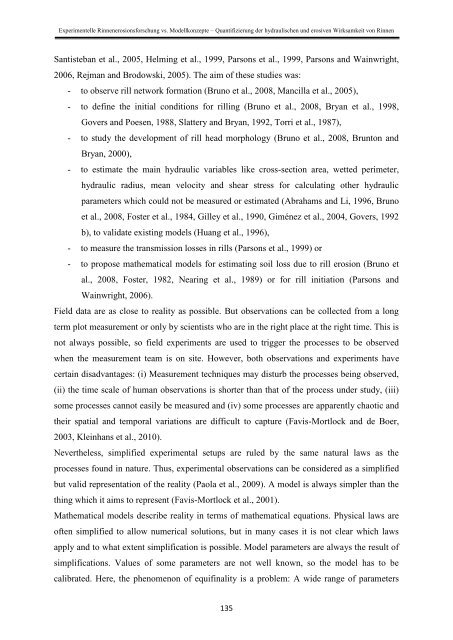Stefan Wirtz Vom Fachbereich VI (Geographie/Geowissenschaften ...
Stefan Wirtz Vom Fachbereich VI (Geographie/Geowissenschaften ...
Stefan Wirtz Vom Fachbereich VI (Geographie/Geowissenschaften ...
Create successful ePaper yourself
Turn your PDF publications into a flip-book with our unique Google optimized e-Paper software.
Experimentelle Rinnenerosionsforschung vs. Modellkonzepte – Quantifizierung der hydraulischen und erosiven Wirksamkeit von Rinnen<br />
Santisteban et al., 2005, Helming et al., 1999, Parsons et al., 1999, Parsons and Wainwright,<br />
2006, Rejman and Brodowski, 2005). The aim of these studies was:<br />
- to observe rill network formation (Bruno et al., 2008, Mancilla et al., 2005),<br />
- to define the initial conditions for rilling (Bruno et al., 2008, Bryan et al., 1998,<br />
Govers and Poesen, 1988, Slattery and Bryan, 1992, Torri et al., 1987),<br />
- to study the development of rill head morphology (Bruno et al., 2008, Brunton and<br />
Bryan, 2000),<br />
- to estimate the main hydraulic variables like cross-section area, wetted perimeter,<br />
hydraulic radius, mean velocity and shear stress for calculating other hydraulic<br />
parameters which could not be measured or estimated (Abrahams and Li, 1996, Bruno<br />
et al., 2008, Foster et al., 1984, Gilley et al., 1990, Giménez et al., 2004, Govers, 1992<br />
b), to validate existing models (Huang et al., 1996),<br />
- to measure the transmission losses in rills (Parsons et al., 1999) or<br />
- to propose mathematical models for estimating soil loss due to rill erosion (Bruno et<br />
al., 2008, Foster, 1982, Nearing et al., 1989) or for rill initiation (Parsons and<br />
Wainwright, 2006).<br />
Field data are as close to reality as possible. But observations can be collected from a long<br />
term plot measurement or only by scientists who are in the right place at the right time. This is<br />
not always possible, so field experiments are used to trigger the processes to be observed<br />
when the measurement team is on site. However, both observations and experiments have<br />
certain disadvantages: (i) Measurement techniques may disturb the processes being observed,<br />
(ii) the time scale of human observations is shorter than that of the process under study, (iii)<br />
some processes cannot easily be measured and (iv) some processes are apparently chaotic and<br />
their spatial and temporal variations are difficult to capture (Favis-Mortlock and de Boer,<br />
2003, Kleinhans et al., 2010).<br />
Nevertheless, simplified experimental setups are ruled by the same natural laws as the<br />
processes found in nature. Thus, experimental observations can be considered as a simplified<br />
but valid representation of the reality (Paola et al., 2009). A model is always simpler than the<br />
thing which it aims to represent (Favis-Mortlock et al., 2001).<br />
Mathematical models describe reality in terms of mathematical equations. Physical laws are<br />
often simplified to allow numerical solutions, but in many cases it is not clear which laws<br />
apply and to what extent simplification is possible. Model parameters are always the result of<br />
simplifications. Values of some parameters are not well known, so the model has to be<br />
calibrated. Here, the phenomenon of equifinality is a problem: A wide range of parameters<br />
135
















